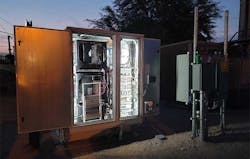Vapor IO Targets ‘Near Premises’ with More Sites, Smaller Modules
Edge computing specialist Vapor IO says it is ready for its next phase of growth, and is refining its business model around “near-premises” applications. The company has also shifted to a smaller form factor for its micro modular data centers, and has laid the groundwork to deploy a broader network of edge colocation sites.
Vapor IO launched in 2017 with ambitions to deploy hundreds of advanced modular data centers at the base of telecom towers. The company has taken a broad approach that combines software-driven management with expertise in networking and data center hardware. Its business model and deployment plans have evolved along with the edge computing market.
“Our sweet spot today is delivering on-premises performance and security with the convenience sand economics of cloud,” said Matt Trifiro, Chief Marketing Officer of Vapor IO. “This is where we’re gaining traction. There’s tremendous demand for enterprises to continue to move workloads off premises, so we’re focusing on near-premises (deployments).”
Trifiro said Vapor IO can deploy a modular data center near a company’s on-premises data center, allowing companies to move applications out of legacy facilities while maintaining low-latency performance. Use cases include private wireless networks, as well as enabling denser compute infrastructure to support resource-intensive applications like video security. Vapor IO also hopes to enable SaaS service providers to move gear closer to corporate customers to deliver low-latency services.
“Our Kinetic Grid platform is enabling new use cases with new economics, reducing the time, cost and complexity of our customers’ multi-market edge deployments,” said Cole Crawford, founder and CEO of Vapor IO. “Vapor IO has a multi-year lead in providing production-grade infrastructure for edge-to-edge computing, and we’ve been working tirelessly to meet demand and bring the Kinetic Grid to additional markets.”
Now Customer Ready in 26 Sites
Edge computing moves data processing and services as close to the end user as possible. The trend has driven by the increased use of consumer mobile devices, especially consumption of video and virtual reality content and the growth of sensors as part of the Internet of Things. But edge computing also supports business-to-business applications that require low latency.
Vapor IO’s Kinetic Edge uses software and high-speed connectivity to bring multiple micro data center facilities into a single virtual facility with multiple availability zones. Modules are meshed together with high-speed fiber across a group of data centers. The design builds upon the “availability zone” approach popularized by Amazon Web Services, creating a cluster of local data centers to easily hand off data and traffic.
In early 2020, Vapor IO said it was fully funded to deploy 32 edge sites by the end of 2021. It currently operates its Kinetic Grid network in six cities – Las Vegas, Phoenix, Chicago, Atlanta, Dallas and Pittsburgh.
Today Vapor IO announced that an additional 26 cities are “customer ready,” meaning that Vapor IO has permitted sites with a concrete pad and power and network connectivity in place. Vapor IO says it can deploy a Vapor Edge Module (VEM) micro data center at these locations within 90 days.
Moving Beyond Round Rack Enclosures
A Vapor IO VEM20 micro data center module is lowered onto a pad at a site in Las Vegas. (Photo: Vapor IO)
That delivery model has evolved as well. Vapor IO initially designed its VEM modules for six of its round Vapor Chambers – a round enclosure that can support six racks positioned in a ring – and up to 150 kW of IT power.
It is now optimizing around the VEM20, a smaller module that houses two 10 kW racks. That has meant a shift to traditional racks instead of the distinctive Vapor Module enclosure that created a buzz upon its debut. The Vapor Chamber was a round enclosure that supported six racks positioned in a ring. Cool air would enter from the exterior, with waste heat contained in a central vertical column, allowing airflow to be managed with minimal use of fans.
“The VEM20s are smaller, have fewer visual issues and make less noise,” said Trifiro. “It tends to be a lot easier to get these permitted.”
The 32 available markets are Atlanta, Birmingham, Boston-Worcester, Buffalo, Charlotte, Chicago, Cincinnati/Dayton, Cleveland, Columbus, Connecticut, Dallas, Denver, Fort Myers, Houston, Indianapolis, Jacksonville, Las Vegas, Los Angeles, Miami, Minneapolis, Nashville, Orlando, Philadelphia, Phoenix, Pittsburgh, Providence, Raleigh, Rochester, San Antonio, Seattle, Syracuse, Tampa, and Washington DC-Baltimore.






